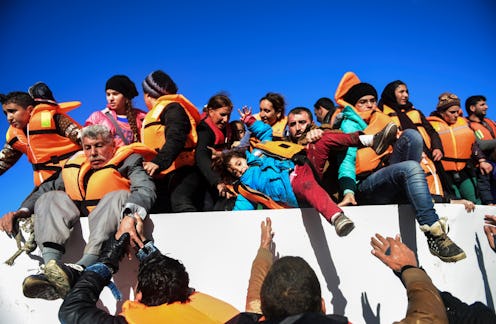News
10000 Syrian Refugees Should Only Be The Beginning
On Monday, the White House trumpeted some good news on the Syrian refugee front: the administration had successfully welcomed 10,000 Syrian refugees, meeting its target ahead of schedule. While that is a significant accomplishment, the United States accepting 10,000 refugees is nowhere near enough. For every Syrian family resettled in the United States, there are many more refugees, from other countries as well, still fleeing violence caused by ISIS. That point was hammered home by a huge rescue operation off the Libyan coast, also Monday, of some 6,500 migrants. And that's in just one day.
The water rescue was actually some 40 coordinated rescues carried out about 12 miles off the North African coast by the Italian Coast Guard, BBC News reported. The EU border agency and NGOs including Doctors Without Borders also participated. "We've been particularly busy today," a spokesperson for the Italian Coast Guard told the AFP.
This is one of the largest one-day rescues seen in the Mediterranean this year, but the news agency reported 13,000 were rescued in one week in May and that 8,300 were rescued at the beginning of August. It's not uncommon for ships to leave Libya in waves during good weather — another 1,100 were rescued Sunday and more could set sail toward Italy in the coming days.
The rescue is then just the beginning. And here is where we see the United States falling short. The 6,500 people will be brought to Italy, where 106,000 people have arrived already this year. Compare that with the United States, which has welcomed 63,000 total refugees as of mid-August. The U.S. population is about five times larger than Italy's. Germany expects 300,000 asylum seekers to apply this year.
Geography, of course, plays a role, but even in North America more can be done. Canada has been out-welcoming the United States. They have resettled more than 30,000 Syrians this year. Another 22,000 applications are being processed or have been finalized, but the refugees have yet travel to Canada. The population of the U.S. is nine times larger.
The Obama administration would be quick to point out that we increased our Syrian refugees by six-fold this year, but that is still not enough. Tarah Demant, senior director of the U.S. branch of Amnesty International, called on the government to do more in a statement:
Thousands of families from Syria have found safety on our shores, and that is a wonderful thing. But so many are still trapped in horrific conditions in refugee camps or war zones. The U.S. must do more to uphold its responsibility to do all it can to protect those fleeing human rights abuses.
One thing to recognize is that most of the migrants taking the Libya route are not from Syria. Reports point to the bulk being from Eritrea and Somalia, but that could change. For Syrians, the most popular route has been across the Aegean Sea from Turkey to Greece. That all ended earlier this year, however, when the EU made a deal with Turkey to return migrants that make it to shore or are rescued along the way.
That combined with many countries in the Balkans closing their borders, and routes like this Libya to Italy trek will look more appealing. Unfortunately this Central Mediterranean route is the most dangerous one. According to the International Organization for Migration, 86 percent of the deaths in the Mediterranean happen here.
There are a total of 4.8 million Syrians who have fled to neighboring countries and await settlement from the United Nations High Commissioner for Refugees. Another six million are displaced within Syria. In Total, UNHCR estimates 21.3 million refugees from all countries await resettlement around the world. The United States simply must do more.
